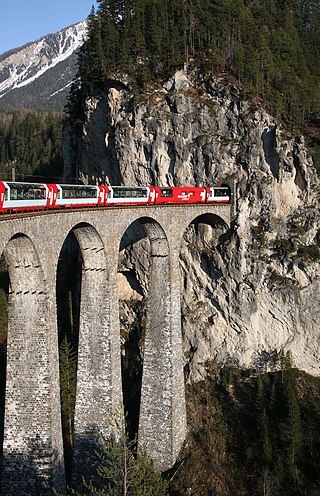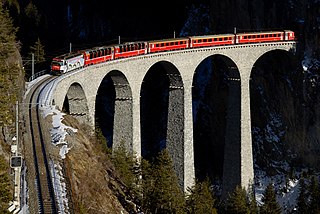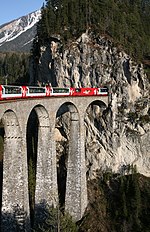
The Rhaetian Railway, abbreviated RhB, is a Swiss transport company that owns the largest network of all private railway operators in Switzerland. Headquartered in Chur, the RhB operates all the railway lines of the Swiss canton of Grisons, except for the line from Sargans to the cantonal capital, Chur, which are operated by Swiss Federal Railways (SBB CFF FFS), as well as the line from Disentis/Mustér to the Oberalp Pass and further on to Andermatt, Uri, which is operated by Matterhorn Gotthard Bahn (MGB). Inaugurated in 1888 and expanded from 1896 onwards in various sections, the RhB network is located almost entirely within Grisons, with one station across the Italian border at Tirano.

The Glacier Express is a direct train connecting railway stations of the two major mountain resorts of Zermatt and St. Moritz via Andermatt in the central Swiss Alps. The train provides a one-seat ride for an 8-hour end-to-end 291-kilometre (181 mi) journey, and omits stops made by local trains. The Glacier Express has been called the 'slowest express train in the world'. As St. Moritz and Zermatt are home to two well-known mountains, the Glacier Express is also said to travel from Matterhorn to Piz Bernina.

Preda is a small village within the Swiss municipality of Bergün Filisur, district of Albula, Canton Graubünden (Grisons), in the East of Switzerland.

The Landwasser Viaduct is a single-track six-arched curved limestone railway viaduct. It spans the Landwasser between Schmitten and Filisur, in the canton of Graubünden, Switzerland.

The Bernina Express is a train connecting Chur in Switzerland to Poschiavo in Switzerland and Tirano in Italy by crossing the Swiss Engadin Alps. For most of its journey, the train also runs along the World Heritage Site known as the Rhaetian Railway in the Albula / Bernina Landscapes.

Val Poschiavo is a valley in the southern, Italian-speaking part of the Swiss canton of the Grisons. The main town is Poschiavo.

The Albula railway line is a single track metre gauge railway line forming part of the core network of the Rhaetian Railway (RhB), in the canton of Graubünden, Switzerland. It links Thusis on the Hinterrhein at 697 m (2,287 ft) and Filisur at 1,080 m (3,540 ft) with the spa resort of St. Moritz in Engadine at 1,774 m (5,820 ft).

The Bernina railway line is a single-track 1,000 mmmetre gauge railway line forming part of the Rhaetian Railway (RhB). It links the spa resort of St. Moritz, in the canton of Graubünden, Switzerland, with the town of Tirano, in the Province of Sondrio, Italy, via the Bernina Pass. Reaching a height of 2,253 metres (7,392 ft) above sea level, it is the highest railway crossing in Europe and the third-highest railway in Switzerland. It also ranks as the highest adhesion railway of the continent, and—with inclines of up to 7%—as one of the steepest adhesion railways in the world. The elevation difference on the section between the Bernina Pass and Tirano is 1,824 m (5,984 ft), allowing passengers to view glaciers along the line.

Filisur railway station is a railway station in the municipality of Filisur, in the Swiss canton of Graubünden. It is located at the junction of the 1,000 mmmetre gauge Albula and Davos Platz–Filisur lines of the Rhaetian Railway. Hourly services operate on both lines.

St. Moritz railway station is a railway station in the resort town of St. Moritz, in the Swiss canton of Graubünden. It is the southern terminus of the Albula Railway line from Chur, and a northern terminus for the Bernina Railway line from Tirano in Italy. The station also serves as a terminus for local bus and Postbus services.

Pontresina railway station is a railway station in the municipality of Pontresina, in the Swiss canton of Graubünden. It is located at the junction of the Bernina and Samedan–Pontresina lines of the Rhaetian Railway.

Morteratsch railway station is a railway station in the municipality of Pontresina, in the Swiss canton of Graubünden. It is located on the Bernina line of the Rhaetian Railway. The Morteratsch Glacier lies some 3 km (1.9 mi) to the south of the station and can be reached by a marked hiking trail.

Bernina Lagalb railway station is a railway station in the municipality of Pontresina, in the Swiss canton of Graubünden. It is located on the Bernina line of the Rhaetian Railway.

Alp Grüm railway station is a railway station in the municipality of Poschiavo, in the Swiss canton of Graubünden. It is located on the south side of Bernina Pass, on the Bernina line of the Rhaetian Railway. It serves the hamlet of Alp Grüm, which, except in summer, is accessible only from the railway. From the station, thanks mainly to the 180° curve immediately to the south, there are far-reaching views of the Palü Glacier, Lago Palu and the Puschlav.

Le Prese railway station is a railway station in the village of Le Prese, within the municipality of Poschiavo and canton of Graubünden in Switzerland. It is located on the Bernina line of the Rhaetian Railway.

Miralago railway station, previously known as Meschino railway station, is a station in the village of Miralago, within the municipality of Poschiavo and in the Swiss canton of Graubünden. It is located on the Bernina line of the Rhaetian Railway.

Brusio railway station is a railway station in the municipality of Brusio, in the Swiss canton of Graubünden. It is located on the 1,000 mmmetre gauge Bernina line of the Rhaetian Railway. Hourly services operate on this line.

Campascio railway station is a railway station in the municipality of Brusio, in the Swiss canton of Graubünden. It is located on the 1,000 mmmetre gauge Bernina line of the Rhaetian Railway. Hourly services operate on this line, but not all trains stop at this station.

Campocologno railway station is a railway station in the municipality of Brusio, in the Swiss canton of Graubünden. It is located at the border between Italy and Switzerland and is an intermediate stop on the 1,000 mmmetre gauge Bernina line of the Rhaetian Railway. Hourly services operate on this line.

The Bernina-Bahngesellschaft Ge 4/4 82, later known as the Rhaetian Railway Ge 4/4 182, is a 1,000 V DC metre gauge B′B′ electrically powered heritage locomotive made in Switzerland.

























